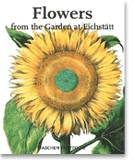Flowers from the Garden at Eichstatt
In 1613 the Nuremberg apothecary Basilius Besler (1561-1629) published the Hortus Eystettensis, or "the conscientious and meticulous specification and vivid representation of all plants, flowers and trees ...", a book that remains to this day one of the great treasures of botanical literature.
Prince-Bishop Johann Konrad of Gemmingen (1593/95-1612) who had the Willibaldsburg castle (begun in 1355) remodelled into a stately Renaissance palace also commissioned the gardens in Eichstatt. The Hortus Eystettensis was designed in eight individual garden areas on different levels around the castle. By the standards of the time, the garden contained many rare plants, among them tulips, hyacinths, and crowns imperial. Thus the garden reflected the prince-bishop's botanic interests as well as serving as an impressive demonstration of his standing.
The book contains a total of 367 copperplate engravings depicting almost 1100 species of plants. The sequence of the plates roughly follows the flowering time of the plants illustrated. Thus the order is based less on botanical classification than on horticultural practice through the year. The Hortus Eystettensis in print became a mirror of the bishop's garden in Eichstatt, already admired by contemporaries. The selection presented here conveys an impression of the splendour and diversity of that famous book.
The Garden at Eichstatt portfolio features high quality prints that beg to be framed. Tucked in the portfolio are 14 large-format reproductions, each with a brief description.
In 1613 the Nuremberg apothecary Basilius Besler (1561-1629) published the Hortus Eystettensis, or "the conscientious and meticulous specification and vivid representation of all plants, flowers and trees ...", a book that remains to this day one of the great treasures of botanical literature.
Prince-Bishop Johann Konrad of Gemmingen (1593/95-1612) who had the Willibaldsburg castle (begun in 1355) remodelled into a stately Renaissance palace also commissioned the gardens in Eichstatt. The Hortus Eystettensis was designed in eight individual garden areas on different levels around the castle. By the standards of the time, the garden contained many rare plants, among them tulips, hyacinths, and crowns imperial. Thus the garden reflected the prince-bishop's botanic interests as well as serving as an impressive demonstration of his standing.
The book contains a total of 367 copperplate engravings depicting almost 1100 species of plants. The sequence of the plates roughly follows the flowering time of the plants illustrated. Thus the order is based less on botanical classification than on horticultural practice through the year. The Hortus Eystettensis in print became a mirror of the bishop's garden in Eichstatt, already admired by contemporaries. The selection presented here conveys an impression of the splendour and diversity of that famous book.
The Garden at Eichstatt portfolio features high quality prints that beg to be framed. Tucked in the portfolio are 14 large-format reproductions, each with a brief description.














